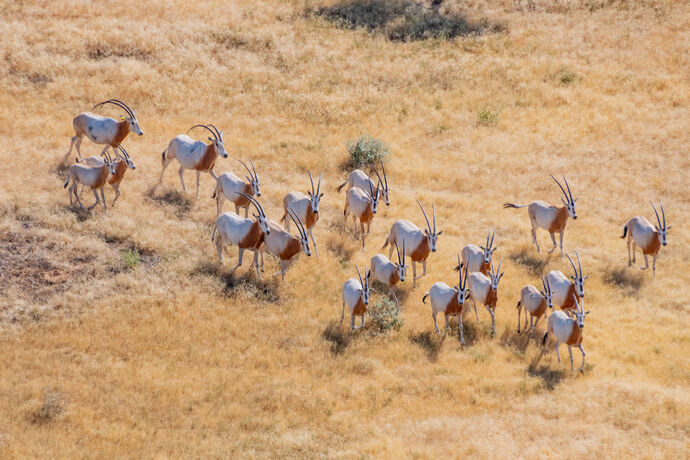The Environment Agency – Abu Dhabi (EAD) continues to progress with the world’s largest mammal reintroduction programme. During the past month the Agency has successfully translocated 20 Scimitar-Horned Oryx (SHO) and 25 Addax to Chad’s Ouadi Rime-Ouadi Achim Game Reserve.
Currently there are 460 Scimitar-Horned Oryx in the wild, with 15 calves born so far this year, as well as 96 wild Addax, with 5 calves born to the herd, also this year,
Furthermore, for the first time ever EAD successfully translocated five Dama Gazelle on the 14th of March 2022, which have joined the herd of other captured wild Dama Gazelle in the Agency programme.
As part of the monitoring programme for the animals, EAD successfully darted 7 wild animals - 6 SHO and 1 Addax - and fitted them with satellite tracking collars, enabling close monitoring to witness survival and reproduction.
Her Excellency Dr. Shaikha Salem Al Dhaheri, Secretary General of EAD, said: "This pioneering project was inspired by the insightful vision of the late Sheikh Zayed bin Sultan Al Nahyan, who noticed that SHO numbers were declining rapidly and wished to see them flourish once again. Today we are seeing continued success thanks to the support of our wise leadership through the regular translocation of both breeds to their natural habitat in Chad. Both herds of animals are now thriving very well in their natural habitats.”
She added: “We are currently very close to achieving our goal of having a herd of 500 SHO in Chad and, due to the success of this project, we are aiming to go beyond this figure and ensure that the numbers in the wild increase even further. Alongside the SHO herd, we are working closely with the government of Chad to also reintroduce Addax and Dama Gazelles, and in time we will witness increased numbers of these species, hopefully paving the way for their removal them from the extinction danger list.”
The SHO reintroduction programmes strives to create a self-sustaining herd of over 500 heads in the 77,950 km2 Ouadi Rimé-Ouadi Achim Wildlife Reserve, decades after the species was declared ‘extinct in the wild’ by the International Union for the Conservation of Nature (IUCN) in 2000.
Initiated in 2014, with the first shipment of animals released back into their natural habitats in 2016, the herds have been closely monitored to ensure they are adapting well to their wild environment.
The second phase of the reintroduction programme included adding the critically endangered Addax and, in November 2019, the translocation project was launched with the first pilot batch of 15 animals, followed by the second group of 25 Addax in March 2020.
The reintroduction programme of both species involves close collaboration with a range of international partners. These include: the Ministry of Environment in the Government of Chad, the Sahara Conservation Fund (SCF), the Zoological Society of London (ZSL), the Smithsonian Conservation Biology Institute (SCBI), Marwell Wildlife, Royal Zoological Society of Scotland, Saint Louis Zoo WildCare Institute, Fossil Rim Wildlife Center, and the European Union.
Notes:
About Scimitar-Horned Oryx
- SHO are named after their impressive blade-like horns, which are long and curved like a traditional Arabian sword.
- It is difficult to predict how long the SHO can live in the wild, especially given that their native habitat has changed since the species was declared extinct. However, they typically live up to 20 years in captivity.
- SHO can survive for months or even years without drinking water. As a grazing animal, they derive most of their daily moisture intake from the plants they eat.
- Perfectly adapted to the hot, arid desert climate, SHO also have a unique circulation system in their skull, which cools the blood by up to -15 degrees Celsius (5 degrees Fahrenheit) through capillaries in the nose before it reaches the brain.
- SHO can sense the slightest variations in air humidity over distances of more than 100 kilometres. This incredible skill for water divination meant that herds were often followed closely by tribes as they sought water.
About the Addax
- The Addax is an arid-land antelope that is very well adapted to living in the harsh deserts of the Sahara, rarely needing to drink water to survive.
- Unfortunately, the Addax’s impressive spiraling horns, meat and hide have been attractive to humans and their population has plummeted during the last century due to the prevalence of poaching, which has been exacerbated by ubiquitous four-wheel drive vehicles and pressures from oil extraction activities.







